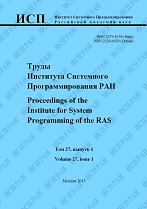|
This article is cited in 3 scientific papers (total in 3 papers)
Realization of parallel computations in the software package «LS-STAG_turb» for viscous incompressible flow simulation on systems with shared memory
V. Puzikova
Bauman Moscow State Technical University, 5 2nd Baumanskaya st., Moscow, 105005, Russian Federation
Abstract:
Immersed boundary methods have become popular in Computational Fluid Dynamics over recent years for simulating flows through complex solid geometries and in coupled hydroelastic problems. The advantage of these methods over a method with a body-fitted mesh is their computational efficiency: they do not require regridding when domain shape changes in the simulation process due to hydroelastic body motion. The LS-STAG method for viscous incompressible flows simulation combines the advantages of immersed boundary methods, the marker and cells (MAC) method and level-set method. The LS-STAG method and its modifications for numerical simulation in coupled hydroelastic problems and for turbulence simulation by using RANS, LES and DES approaches are implemented in the software package «LS-STAG_turb». This software allows to simulate viscous incompressible flows around a moving airfoil of arbitrary shape or airfoils system with one or two degrees of freedom. For example, it allows to simulate rotors autorotation and airfoils system wind resonance. These phenomena are characterized by high velocities of airfoils and high values of local Reynolds number. So, extremely small space and time steps are required to obtain accurate quantitative results. It leads to significant increase in computational cost. To decrease it, the «LS-STAG_turb» parallel version is developed. Intel Cilk Plus, Intel TBB and OpenMP parallel programming technologies are used. Also, serial code sections are optimized. The FGMRES method usage for linear algebraic equations systems solving allows to achieve 2-fold computation time reduction in comparison with the BiCGStab method. In addition, the developed software implementation of the FGMRES method is more efficient than the similar solver implemented in Intel MKL library both for single-core and multi-core computations.
Keywords:
OpenMP technology, Intel Cilk Plus technology, Intel Threading Building Blocks technology, viscous incompressible flow, immersed boundary method.
Citation:
V. Puzikova, “Realization of parallel computations in the software package «LS-STAG_turb» for viscous incompressible flow simulation on systems with shared memory”, Proceedings of ISP RAS, 28:1 (2016), 221–242
Linking options:
https://www.mathnet.ru/eng/tisp13 https://www.mathnet.ru/eng/tisp/v28/i1/p221
|

|




 Contact us:
Contact us: Terms of Use
Terms of Use
 Registration to the website
Registration to the website Logotypes
Logotypes








 Citation in format
Citation in format 
